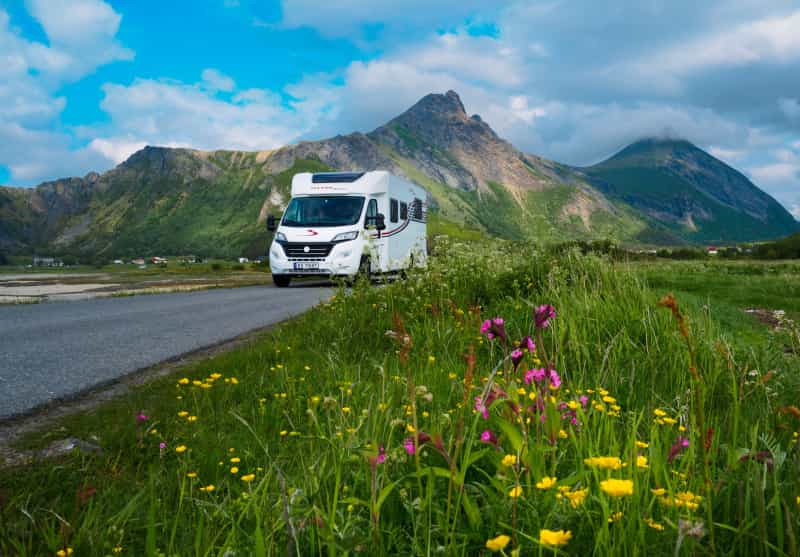Driving a motorhome
If you’ve hired a motorhome – or are driving yours for the first time – you might be approaching the task with a little trepidation. Steering larger vehicles can be tricky to get to grips with right away. But with this guide to help, as well as a bit of practice, you can stay on the right track.

Tips on driving a motorhome
A golden rule when first driving a motorhome is to leave enough time. That way, you can travel slowly and stop frequently until you feel comfortable behind the wheel.
Here’s some more key advice to keep in mind.
-
Motorhomes, as heavier vehicles, are slower than cars, so don't try to get anywhere quickly.
-
Practise reversing while relying on side mirrors (and sensors, if you have them). You won't be able to see much, if anything, out the back of your motorhome or while looking over your shoulder.
-
Drive a little closer to the roadside than normal to make sure you’re not accidentally crossing into other lanes. This is an easy mistake to make in a wide vehicle.
-
Keep in mind that you’ll need more room than usual to swing out at junctions.
-
Get comfortable with your motorhome’s braking speed. Because of the van’s weight, the stopping distance will be longer than in a small car. Try to leave plenty of space between your van and the vehicle in front of you.
-
Check motorhome speed limits. In the UK, for example, vans weighing more than 33.5 tonnes must stick to 50 miles per hour on single carriageways, 60 miles per hour on dual carriageways and 70 miles per hour on motorways.
-
Drive in the slow lane on motorways. It’s usually wider than the other lanes as it needs to cater for large trucks and lorries.
-
Keep driving documents, such as your motorhome insurance, licence and van’s registration details, close by in case you get stopped by the police.
-
Avoid particularly busy urban areas until you’re a highly confident motorhome driver. Instead of risking the stress of driving into a city, stop at a park and ride, motorhome aire, campsite or smaller town with good transport links to the centre.
Motorhome height and weight limits
Memorise or write down your vehicle’s dimensions. Knowing its height, width and length will help you avoid:
-
Getting stuck under low bridges. Height restrictions are clearly marked on these.
-
Being unable to access car parks with height barriers. Many are limited to around 2 metres.
-
Booking a campsite pitch that’s too small. Always check the size of the space you’ll be allocated before arrival.
-
Buying the wrong ticket for a ferry. You have to input the height and length limits during the purchase process.
Can you drive a motorhome with a car licence?
You don’t need a special motorhome licence to drive smaller residential vehicles weighing less than 3.5 tonnes, as your usual car licence (category B) covers you.
In the UK, if you’re a resident and passed your driving test before 1 January 1997 and have a B+C1 licence, you can drive a motorhome weighing up to 7.5 tonnes. However, if you passed after 1 January 1997 then you have to pass an additional C1 test to drive a motorhome weighing more than 3.5 tonnes.
Motorhome parking tips
Parking a motorhome isn't quite as easy as parking a car. Here's what to keep in mind.
-
Use a website like Parkopedia to locate accessible parking spots. It can be difficult to find a parking bay that’s big enough for a motorhome in cities, and height restrictions on multi-storeys limit the options even further.
-
Reverse park into bays where possible so that you can drive straight out of the spot when leaving.
-
Ask one of your passengers to jump out and guide you while reverse parking, especially if there are lots of people or obstacles around.

Motorhome driving courses
Have the right licence but still want to enhance your skills – and confidence – while steering a large vehicle? There are specialist motorhome driving courses available. Look out for options that will guide you on how to manoeuvre and reverse your van, as well as drive it on the motorway and in cities.
Motorhome driving FAQs
Can I sleep in a motorhome while someone is driving?
Sleeping in a motorhome bed while someone is driving is illegal in most countries, including across Europe. If your passenger is tired, they’ll need to nap up front while wearing a seatbelt.
Can I carry passengers in the back of my motorhome?
If you have people in the rear of your van, they need to be in official travel seats and secured with a seatbelt. If you don’t have seatbelts in the rear, it’s illegal to carry any passengers there.
Can you park a motorhome on your drive?
Yes, if it fits properly and the property doesn’t have a covenant on it to prevent motorhomes from being parked. You can check the Land Registry to see if this is the case or not. It’s best practice not to let it overhang onto the pavement and to be mindful of blocking your neighbours’ light and/or view. Your motorhome can also usually be parked on the street outside your house as long as it has current road tax and an MOT.
How do I travel in a motorhome with a dog?
The Highway Code says that pets need to be securely restrained while you’re driving so that they can’t distract or injure you – or themselves – if you make a sudden stop. You can use a harness, crate, dog booster seat or dog carrier in tandem with a seatbelt to keep them in place.
Beginners’ guide to motorhome holidays

